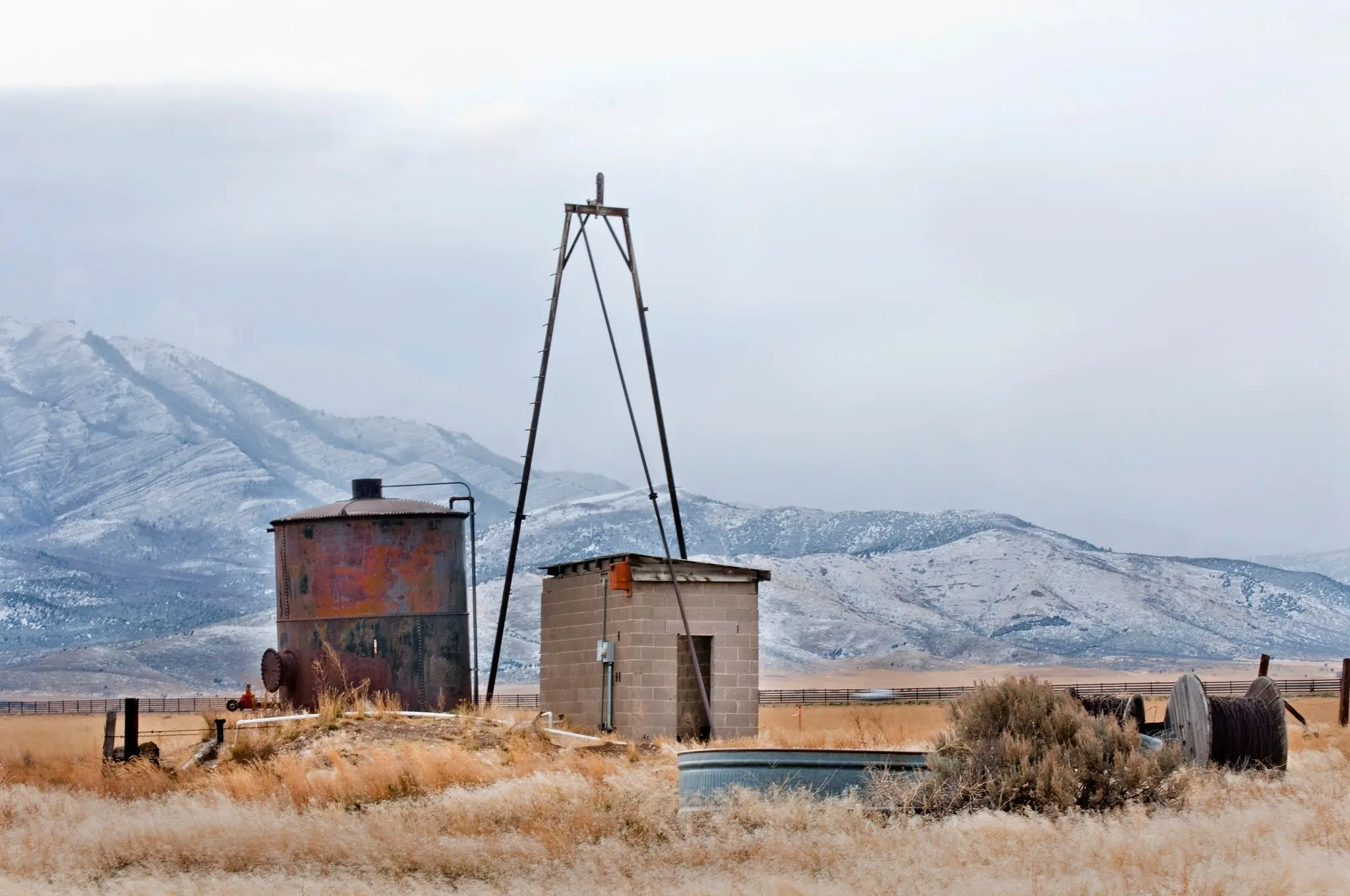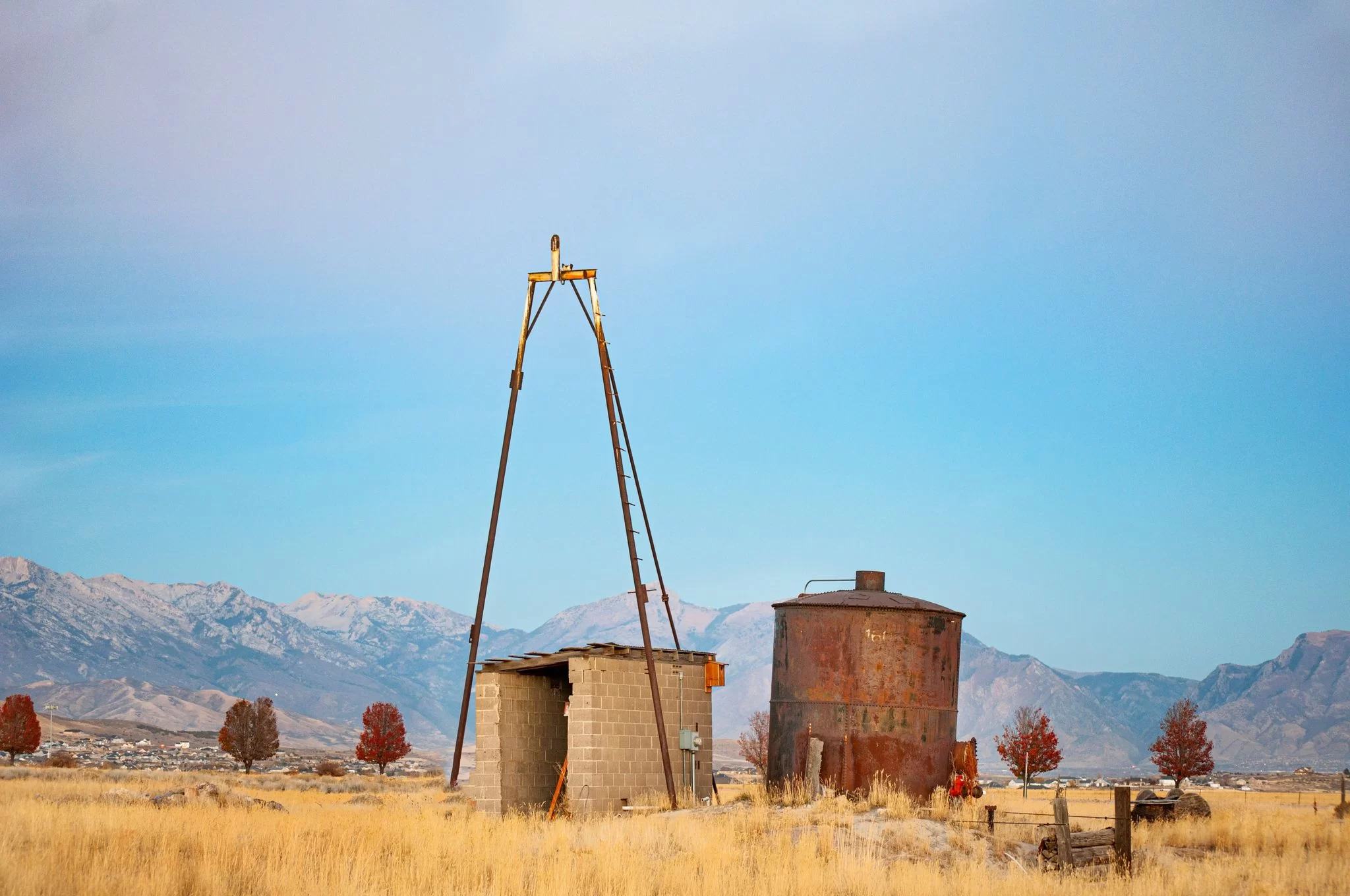I would say that the majority of the time you drive down SR-73 towards City Center and take Eagle Mountain Blvd you will see someone taking a photograph by the old well and well station. It is probably one of the most iconic and photographed spots in Eagle Mountain. I have driven past it several times and have wondered, what it was, how it got there, and who made it. Well, I have found the answers to those questions. (Featured Photo by: Lynnae Chilcott)
Idea Explored – September 1915
Our story starts in September 1915. The American Fork Citizen reports on September 4th, 1915, “New State Well For Cedar Valley”. The article states, “The State Land Board will soon commence sinking for an artesian well in the north end of Cedar Valley.” It continues that several men traveled to the valley in automobiles. The land will be deeded to the state by the current land owner. “The acre tract is located about one mile west of the Tickville wash on the West canyon road where the junction is made with the road to Cedar Fort..” The article continues. “The contract will call for a well 600 feet deep and the casing will be 10 inches, to begin with.”
State Looks For Bids – October 1915
The American Fork Citizen reported that the State is looking for someone to make a well in the Cedar Valley. “The State Land Board is advertising for driving an artesian well in Cedar Valley. All bids must be in by November 1st.” The article continues, “The bidder must be prepared to sink the well 500 feet deep unless the water is encountered at a more shallow depth. The pipe must be of wrought iron and ten inches in diameter.” The article then talks about how it may be a challenge to drill. “Some people are of the opinion that solid rock will be encountered before a depth of 200 feed is reached, as in a ravine that passes close by the location of the well, solid bedrock is exposed less than 20 feed from the surface. The closest water for well-driving purposes would be about three miles distant.”
Bid Awarded To Fairfield Man – November 1915
The State finds a resident of Fairfield, Utah, a town that is also in the Cedar Valley. According to an article in the American Fork Citizen on November 13th, 1915 the bid was awarded to W.C. Thomas of Fairfield. “The State Land Board awarded the contract for the state experiment well in the north end of Cedar Valley to W.C. Thomas of Fairfield. Mr. Thomas has had more experience than any other man in driving wells in Cedar Valley, and up to date he has been very successful.”
About W.C. Thomas
William C. Thomas was born in Fairfield Utah on April 18, 1876. He was the son of William and Ann Hodges Thomas. He married Hannah Walters who died in 1949. He had two sons and one daughter, Max Thomas, Stanley Thomas, and Wilma Thomas. William died in Los Angeles, California on January 3rd, 1964 from “causes incident to age”. The US 1920 census shows that he was a “merchant and farmer”. He owned his own home and was able to read and write. In the 1930 census, his occupation was listed as a farmer.
Life Sketch of William Cluss Thomas by James Abram Carson and Ralph L. Dubois from “Tribute Paid to William C. Thomas, Oldest Fairfield Resident”, The Lehi Free Press, January 1964. Some of the highlights from his life Sketch include, “At an early age he showed signs of being a community builder, and it was this love for his home town that was one of his outstanding characteristics. No matter what the project was, if it improved the town or made living conditions better in Fairfield, Mr. Thomas favored it and lent a willing hand to its achievement. It is doubtful if any small town in Utah ever had a more efficient community worker than this man. He owned and operated the Camp Floyd dance hall. At the turn of the century he organized and trained what he called “The Home Dramatic Troupe,” often writing the plays himself. He organized and managed the Fairfield baseball team, which at that time was one of the best in Utah County.” The sketch continues, “He owned the first car ever to come to Cedar Valley. It was an Oakland, much admired by the neighbors, young and old. He often took the children of Fairfield car-riding with his family. He liked to make the children happy. It is doubtful if anyone ever heard Mr. Thomas say an unkind word about anyone, and he had the habit of refraining from repeating gossip, notwithstanding the fact that his store was more of a meeting place than even the Stage Coach Inn (Carson Hotel). He never used profanity and his habits were clean.”
Well Progress Halted – March 1916
The well ran into a few hiccups while it was being drilled. On March 18th, 1916 the American Fork Citizen reported that ” William Thomas is driving the well and broke a part of his engine which necessitated Mr. Carson’s coming in to Salt Lake for some fixtures.”
The March 25th 1916 issue of the American Fork Citizen continues to give us some details on this drilling stoppage. “William Thomas of Fairfield and Matt Carson went to Salt Lake Tuesday to see the State Land Board to get a month’s release from driving the state well in the north end of Cedar Valley, while Mr. Thomas finishes the well he is driving for the Carson Bros. in the south end.
Mr. Thomas had the Carson well down about 200 feet when he bent the casing and in pulling it up he lost the bottom joint. If given a delay by the Land Board, he will use the new well boring machine on the Carson well.”
Well Progress – October 1916
“William Thomas of Fairfield has been working for the past two weeks on the stat experiment well in the north end of Cedar Valley. The heavy gravel makes the work most difficult and he is only down 50 of the 600 feet called for in the contract.” was reported in the American Fork Citizen on October 7th, 1916.
Well Progresses – November 1916
The American Fork Citizen reported on November 25th, 1916 that the well was progressing. “The progress on the big well in the north end of Cedar Valley is slow owing to the foundation being mainly cobble rock and gravel. No water has been encountered through the dept is reaching near the 400 foot mark. The rig is working long hours that are contracted and can be completed before cold weather hampers the work.” The article continues, “The success of this well means a lot to that section of the country as the well site is centralized to a good advantage. Mr. Thomas has just shipped the last pipe which is 8 inches throughout and hopes to complete the work by December 15.” The article quotes Mr. Thomas as saying, “I have used every precaution to make a decided success of the well an hope to reach the first strata of water in a short time.”
Well Finished – December 1916
The American Fork Citizen reports that the well has been completed. On December 16th, 1916 the paper wrote titled “Cedar Valley Well Gets 100 Feet Water”. “W.C. Thomas has completed the state experiment well in the north end of Cedar Valley. It is down 500 feet and has 100 feet of water in it. The well is located south of the country road going to Cedar Fort, a short distance west of where it crosses the west canyon wash.
A committee, consisting of S.L. Chimpan, J.R. Hidley, and B.G. Webb will go to Salt Lake next week to ask the state land board to drive it deeper in an endeavor to get a flow. If unsuccessful, parties owning the land adjacent will put a gasoline pump on the well.”


How Deep Is the Well?
A report found on the State Water website gives a lot of details on the driving of the well and what was found. “The well situated in the North end of Cedar Valley, in Utah Co. Commenced in Aug 1916. Is driving through mountain wash, as indicated by the log herewith. Several attempts had been made to get water but no acquired necessary depth, as the high bench or delta is from 200 to 400 ft. above the valley in general. This well is directly in wash from the canyon. It is located in a very centralized place for those needing water for culinary use, for which purpose it was driven. This well is cased in the depth of 464 ft with 8 in. wrought iron pipe, (the depth attained at the time of this record).
Below is the actual report.
Supporting Documents
Below are the articles that I clipped from newspapers.com for this article.
Mike Kieffer – Editor-in-Chief, Cedar Valley Sentinel
Mike Kieffer is a dynamic leader and community advocate based in Eagle Mountain, Utah. He serves as the Editor-in-Chief of the Cedar Valley Sentinel, a local publication dedicated to informing, inspiring, and elevating the Cedar Valley community through honest and accurate journalism. With a passion for fostering connections, Kieffer has made it his mission to highlight local businesses, provide reliable news, and support community development.
Beyond his editorial role, Kieffer is the owner of Lake Mountain Media, LLC, a company specializing in media and communications, and the co-owner of Quail Run Farms, which focuses on sustainable farming and community engagement. He also actively contributes to the local economy and culture as a member of the Eagle Mountain Chamber of Commerce.
Kieffer’s dedication extends to preserving and promoting the history and heritage of the Cedar Valley area. He often participates in community-centered events and media, including podcasts that explore the unique aspects of life in the region. Through his varied endeavors, he remains a steadfast advocate for the growth and enrichment of the local community.




So what was the well used for? Drinking water? In the middle of nowhere?
It was used for irrigation.
Thoughtful and thorough research. Interesting too!
River LaMoreaux,
Thank you! I’m glad you found the research interesting. Research is an important part of any project, and it’s important to make sure you’re thorough and thoughtful when conducting it. Doing thorough research can help ensure that your project is accurate and reliable, and can also help you come up with new ideas or solutions to problems.
Debug: 10:68:78:605
Very interesting. Thanks for your research on that old well!
Cody Hall, It’s amazing to think that something like a well could have been in use for hundreds of years. It’s also interesting to think about how it was used and how it may have changed over time. It’s also interesting to consider how the community around the well may have changed over time as well.
Debug: 13:60:73:553